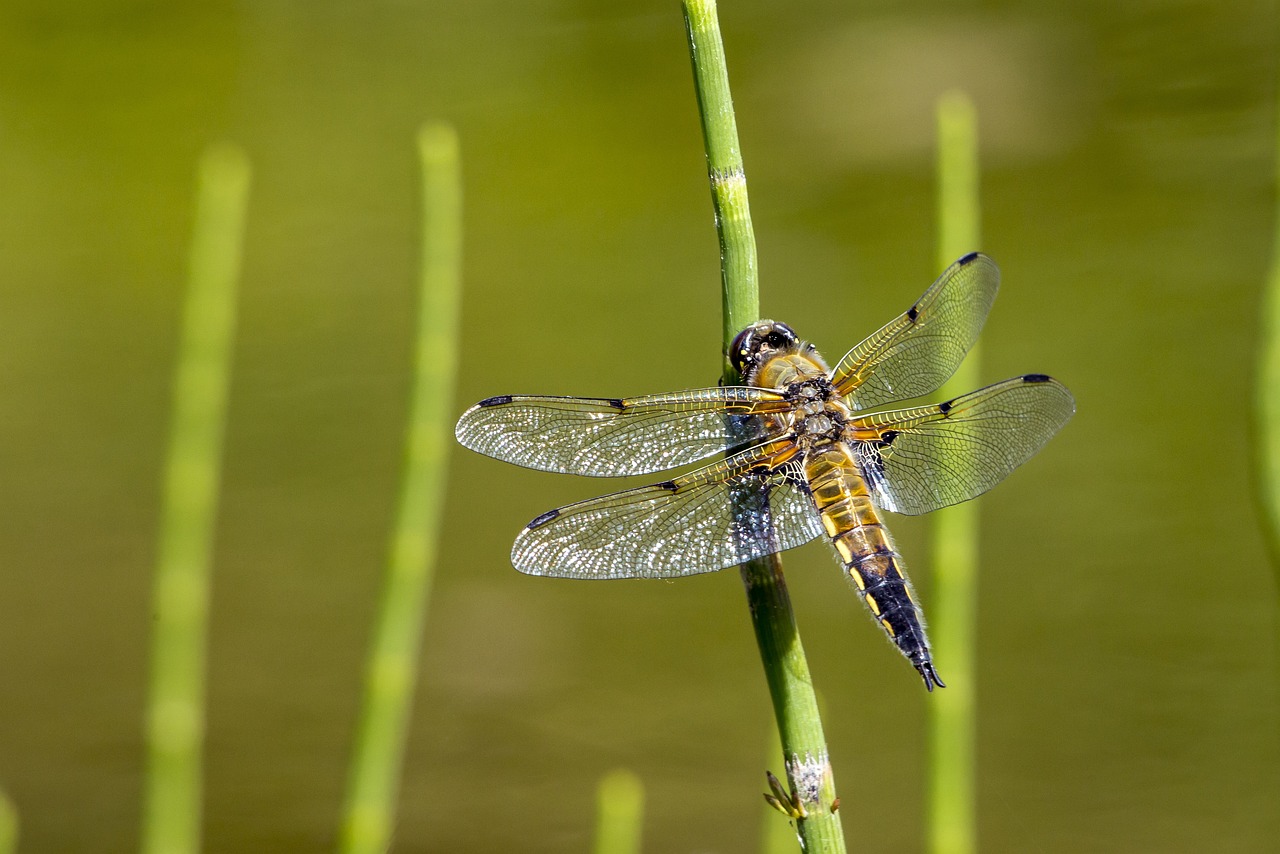The Four-spotted Chaser (Libellula quadrimaculata) is a striking species of dragonfly found across a range of temperate regions in Europe, Asia, and North America. Known for its distinctive wing markings and behavior, it is a favorite among entomologists and nature enthusiasts alike.
Description
- Size:
- The Four-spotted Chaser is a medium-sized dragonfly, with a wingspan ranging from 65 to 85 millimeters and a body length of approximately 40 to 50 millimeters.
- Appearance:
- Body Color: The body is usually a pale yellow or light brown, often with darker markings along the sides.
- Wings: The most distinctive feature of this dragonfly is its wings, which have a characteristic pattern of four dark spots. These spots are located near the wing tips and are most prominent against the clear background of the wings. The wings are transparent with a slight brownish tint and may also have a subtle iridescence.
- Legs: The legs are black with yellow or white markings and are adapted for grasping prey.
- Eyes: The large, compound eyes are typically green or yellow and provide excellent vision for hunting.
Behavior and Ecology
- Habitat:
- The Four-spotted Chaser is commonly found near still or slow-moving water bodies such as ponds, lakes, marshes, and bogs. It prefers sunny areas with ample vegetation, where it can perch and hunt effectively.
- Flight:
- This dragonfly is known for its agile and rapid flight. It often patrols its territory, flying in a characteristic zigzag pattern while hunting for insects. It can hover in mid-air and make sudden, sharp turns to catch prey.
- Diet:
- Predatory Behavior: The Four-spotted Chaser feeds primarily on smaller flying insects, such as mosquitoes, flies, and midges. It catches its prey in mid-air using its strong, spiny legs and then consumes it while in flight.
- Feeding: The dragonfly uses its powerful jaws to grasp and consume its prey. It is an efficient predator, helping to control populations of nuisance insects.
Lifecycle
- Eggs:
- Females lay eggs in or near water, often depositing them in aquatic vegetation or floating debris.
- Nymphs:
- The eggs hatch into aquatic nymphs, which live in the water for several months to a few years, depending on environmental conditions. The nymphs are voracious predators themselves, feeding on other small aquatic invertebrates and larvae.
- Pupation:
- After completing their development, the nymphs climb out of the water and molt into their adult form. This emergence can be a dramatic event, as the dragonfly sheds its exoskeleton and its wings expand.
- Adults:
- The adult Four-spotted Chaser emerges in late spring to early summer and can be seen flying around its breeding grounds throughout the summer. Adults are most active in sunny, warm weather and are often observed perched on vegetation near the water.
Ecological Role
- Predator:
- As a predator of smaller insects, the Four-spotted Chaser plays a crucial role in controlling insect populations. It helps maintain the ecological balance by reducing the numbers of potential pest species.
- Prey:
- The Four-spotted Chaser itself serves as prey for larger predators, including birds and larger insects. Its presence in the ecosystem supports a diverse food web.
Conservation Status
- Distribution:
- The Four-spotted Chaser is widely distributed across its range, including much of Europe, Asia, and North America. It is generally considered to be of least concern, with stable populations.
- Habitat:
- Although the species is adaptable, habitat destruction, particularly the drainage of wetlands and pollution of water bodies, can impact local populations. Conservation efforts focus on preserving natural water habitats and ensuring the health of wetland ecosystems.
Summary
The Four-spotted Chaser (Libellula quadrimaculata) is a striking and ecologically important dragonfly known for its distinctive wing markings and agile hunting behavior. Found near various freshwater habitats, it plays a key role in controlling insect populations and maintaining ecological balance. With its captivating appearance and fascinating lifecycle, the Four-spotted Chaser is a notable species among dragonfly enthusiasts and contributes significantly to its environment.
Views: 1450
Subscribe to the newsletter:
